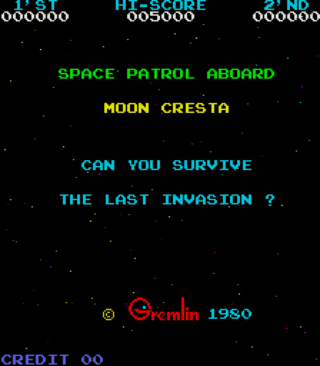|
|
| Line 5: |
Line 5: |
| | | publisher=[[Sega]] | | | publisher=[[Sega]] |
| | | developer=[[Nihon Bussan]] (Japan), <br> [[Gremlin Industries]] (North America) | | | developer=[[Nihon Bussan]] (Japan), <br> [[Gremlin Industries]] (North America) |
| − | | system= | + | | system=[[Sega Galaxian-based hardware]] |
| | | romsize= | | | romsize= |
| | | sounddriver= | | | sounddriver= |
| Line 21: |
Line 21: |
| | | | |
| | ''Moon Cresta'''s success led to a sequel in ''Terra Cresta'' in 1985. Most sequels would skip Sega consoles, however ''[[Terra Cresta 3D]]'' would see a [[Sega Saturn]] release in 1997. | | ''Moon Cresta'''s success led to a sequel in ''Terra Cresta'' in 1985. Most sequels would skip Sega consoles, however ''[[Terra Cresta 3D]]'' would see a [[Sega Saturn]] release in 1997. |
| − |
| |
| − | ==Hardware==
| |
| − | It ran on custom [[List of Sega arcade systems|Sega Z80-based hardware]],{{ref|1=[http://www.system16.com/hardware.php?id=688 Sega Z80 Based Hardware (System 16)]}} based on a modified version of the [[wikia:w:c:gaming:Namco Galaxian|Namco Galaxian]] arcade system board:{{ref|[https://github.com/mamedev/mame/blob/master/src/mame/drivers/galaxian.cpp Namco Galaxian (MAME)]}}{{ref|1=[http://www.system16.com/hardware.php?id=513 Namco Galaxian Hardware (System 16)]}}{{ref|[https://github.com/mamedev/mame/blob/master/src/mame/video/galaxian.cpp Namco Galaxian video hardware (MAME)]}}
| |
| − |
| |
| − | {{multicol|
| |
| − | * Main [[wikipedia:Central processing unit|CPU]]: [[Zilog Z80]] @ 3.072 MHz (8-bit & 16-bit instructions @ 0.45 [[wikipedia:Instructions per second|MIPS]])
| |
| − | * Sound hardware: Namco Galaxian sound hardware (one [[wikipedia:Programmable sound generator|programmable]] 4/8-bit [[wikipedia:Waveform|waveform]] channel, three 4-bit [[wikipedia:Square wave|square wave]] channels, two 17-bit [[wikipedia:White noise|noise]] channels, one [[wikipedia:Modulation|modulated]] noise [[wikipedia:Pulse wave|pulse]] channel)
| |
| − | * [[wikipedia:Graphics processing unit|GPU chipset]]: Namco Galaxian video hardware
| |
| − | * Display [[resolution]]: 256×224 (horizontal), 224×256 (vertical)
| |
| − | * [[wikipedia:Overscan|Overscan]] resolution: 384×264 (horizontal), 264×384 (vertical)
| |
| − | * [[wikipedia:Refresh rate|Refresh rate]]: 60.60606 Hz ([[wikipedia:V-sync (video)|V-sync]])
| |
| − | * [[wikipedia:Color model|Color model]]: [[wikipedia:RGB color model|RGB]]
| |
| − | ** Color [[palette]]: 224 ([[wikipedia:RGB color model|RGB]],{{ref|1=[http://www.arcade-museum.com/game_detail.php?game_id=7885 Galaxian (Arcade Museum)]}} [[wikipedia:Programmable read-only memory|PROM]])
| |
| − | ** Colors on screen: 32 (palette [[RAM]])
| |
| − | * Background planes:
| |
| − | ** [[wikipedia:Tile engine|Tilemap]] plane: 8×8 tile sizes, scrolling
| |
| − | ** [[wikipedia:Bitmap|Bitmap]] plane: Star generator, scrolling
| |
| − | * [[Sprite]] capabilities: 8×8 to 16×16 sizes, 4 colors per sprite, 15 sprites per scanline, 240 [[texel]]s per scanline, sprite flipping, sprite animation{{ref|[http://www.cs.columbia.edu/~%20sedwards/classes/2011/4840/reports/Galaxian.pdf Galaxian CSEE 4840 Embedded System Design (University of Columbia)]}}
| |
| − | }}
| |
| | | | |
| | ==Physical scans== | | ==Physical scans== |
This short article is in need of work. You can help Sega Retro by adding to it.
Moon Cresta is a vertical arcade shoot-'em-up developed by Nihon Bussan and originally released in 1980. Sega obtained a license to distribute the game in the United States, with Gremlin Industries making minor modifications to the game for US audiences.
There are many slightly different variants of Moon Cresta (including Gremlin's "sequel", Super Moon Cresta). The Gremlin version makes a few subtle changes to enemy behaviour.
Moon Cresta's success led to a sequel in Terra Cresta in 1985. Most sequels would skip Sega consoles, however Terra Cresta 3D would see a Sega Saturn release in 1997.
Physical scans
Template:Scanflyer
| US
|
|
|
 Manual  Service Manual |
References
